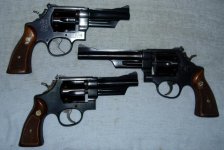First, it is the L-framed guns that were designed around the .357. The original .357/M-27 was simply big enough and strong enough to take the new load, when it wasn't known what it would take to endure under the pounding of the original loading. The alternative was the smaller K-frame, not then made with strong enough steel and advanced heat treatment to be a candidate. Also, the .357 was thought to recoil so severely that few could have handled it in the M&P-sized gun. (The present very light .357's are, I think, a serious mistake. They represent a triumph of marketing over common sense.)
The heavy M-27/28 cylinder does place more strain on the timing mechanism, as the holes in it are smaller than when the cylinder is bored for the .44 cartridges for which this frame size was designed...in about 1907. Also, the cylinder is too short to accept some magnum handloads with longer bullets.
Nor is the M-27 made normally in stainless steel in the usual configuration. The M-686 is.
The .41 (L) frame is all that's needed for a .357. Some will wish for a normal S&W configuration for the barrel. The M-686 barrel was copied from that on the Colt Python, and has a noticeable forward balance. Some prefer that; some don't. The relatively scarce Mountain Gun M-686 is a wise option, if available.
-
I've owned M-27's, M-28's, and one M-686, with a four- inch barrel. The last was the most practical .357 that I've owned, other than Ruger's magnificent GP-100. (I greatly admire the smaller M-66, but not for a great deal of .357 use.)
The big .N (.44) frame of the older guns is too much for many shooters, especially women. It requires a large hand.
The role of the M-27 at this time is mainly one of nostalgia. It is a very effective .357, especially with the six-inch barrel, with which it is best balanced, I believe. But it will probably go out-of-time sooner than the smaller-framed guns, with their lighter cylinders. Nor is it available in stainless, except as the M-627, which does not have the original profile. For serious daily use, stainless construction is a major boon. This is especially so in humid or salty climates.
The M-27 and M-28 are good guns but not the best practical .357 choices in modern times. Some will dispute this but those are the facts.
T-Star
P.S. I do think the M-27 with the 8.3-inch barrel balances better than the long L-frame guns, but I see no real use for such guns, and dislike them. Too much barrel for real world use, except in hunting or target games, where a .44 Magnum really makes more sense. Even then, Ruger's 7.5-inch barrels are my personal limit.


